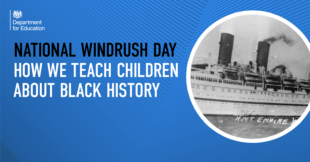
National Windrush Day 2023 marks the 75th anniversary of the arrival of the passengers of the Empire Windrush to the UK. The day celebrates the vital contribution and achievements of the Windrush generation and their descendants.
The freedom and flexibility of the national curriculum mean that historic events such as Windrush can be taught in schools, and many teachers and schools already make sure that these are discussed in the classroom.
Learning about how different groups have contributed to the development of Britain to make us the nation we are today is a key part of a broad and balanced curriculum. This includes reflecting the voices and experience of Black people.
How is Black history taught in schools, including events like the arrival of the Empire Windrush?
History is a varied and diverse subject and Black history can be appropriately embedded into the curriculum.
Here are just some examples of where Black history can be taught using the national curriculum:
- At Key Stage 1 the curriculum should teach children about key historical events within or beyond living memory. This could include lessons about the significance of the Windrush generation to our national life, and the lives of key Black historical figures in the context of the UK.
- At Key Stage 2 the curriculum should cover the study of one non-European society that contrasts with British history and includes the example of Benin (West Africa) from 900-1300 AD.
- At Key Stage 3 the history curriculum explores ideas, political power, industry and empire in Britain between 1745-1901, so that every child has an understanding of the history and consequences of Empire. Key Stage 3 pupils must also study an aspect of British history that extends their chronological knowledge, such as the impact of the migration of people to, from and within the British Isles.
- At Key Stage 4 pupils studying GCSE history should develop and extend their knowledge and understanding of key events, periods and societies in local, British, and wider world history. Teaching should reflect the wide diversity of human experience. This could include the impact of migration on Britain.
We’re currently developing a new Model History Curriculum that will be published next year.
The Model History Curriculum will support schools to teach history content that is high-quality and diverse. It will include teaching on how Britain has influenced and been influenced by different societies and communities. It will also reflect the richness of world history – teaching pupils about societies and civilisations both within and beyond Europe.
Useful resources to teach children about Black history
- Historical Association – resources about Windrush 75.
- Windrush Foundation – provides a Key Stage 2 Windrush education resource including activities, information and photographs.
- BBC Bitesize – resources about the Empire Windrush.
- National Archives – ‘Marking the arrival of the Empire Windrush 75 years on’, resources and activities marking the anniversary.
- Oak National Academy – a selection of Black history resources available for both English and history lessons including on the resistance to slavery in Jamaica in the 19th century and on the Windrush.